Addresses and places can be identified on the map using either the What's here? tool or the Address Inspector tool  . The What's here? tool can return multiple results from each locator enabled in the project and display them in a pop-up. The Address Inspector tool uses a single locator to return a single address or place that is closest to the location identified on the map, displayed in a pop-up.
. The What's here? tool can return multiple results from each locator enabled in the project and display them in a pop-up. The Address Inspector tool uses a single locator to return a single address or place that is closest to the location identified on the map, displayed in a pop-up.
What's here? tool
You can identify addresses and locations on the map using any of the locators added to your project from your active portal using the What's here? tool.
- Pan or zoom on the map to a location where you want to identify an address or place, and right-click a location on the map. Select What's here? from the context menu that appears.
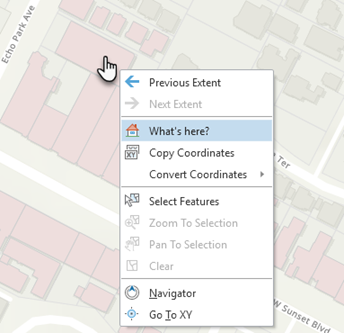
A pop-up appears that displays the information for the addresses, places, or intersections closest to the location that you right-clicked.
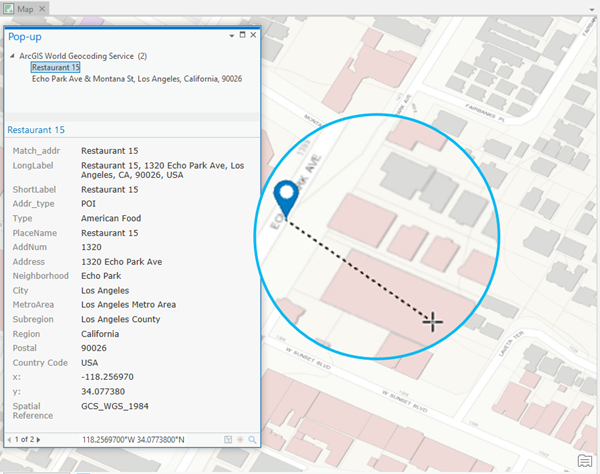
Note:
By default, all the locators added to your project are used for identifying addresses and places on the map. You can turn locators on or off for each map in the project by clicking the Options button  on the Locate tab of the Locate pane.
on the Locate tab of the Locate pane.
To use any locators in addition to the World Geocoding Service or geocode services from your portal connection, add them to your project.
To view the available locators in your project, browse to the Catalog pane. Opened by default, this pane shares space with the Locate pane, so you may need to select it using the tab at the bottom of the pane.
The Locators folder  contains a list of available locators. Click it to expand the contents.
contains a list of available locators. Click it to expand the contents.
Reverse geocoding search tolerance is limited by a hierarchy of search tolerances or 500m for single role locator or when only a single feature type is selected in the features to support reverse geocoding setting on the Locator Properties dialog box. When you are reverse geocoding and want to return results for POI, Parcel, Postal, and Administrative areas, use a polygon to represent these features when building a locator. A reverse result is returned if the input intersects the boundary of the feature.
Address Inspector tool
The Address Inspector tool uses a locator to find the address closest to an identified location on the map.
You can use the Address Inspector tool  to click the map and get the address or place-name of that location. This process is often called reverse geocoding. The Address Inspector tool allows you to see what potential addresses are near the location you clicked, as well as the location of the address. This can be helpful when using a street-based locator to help assign addresses to homes or parcels in a new housing development. You can see what addresses are available along the street to ensure you assign a valid house number to the new parcel or address point. A multirole locator that consists of PointAddress and StreetAddress roles used in the tool can help to validate the new addresses against the streets and existing parcels or address points at the same time for more efficiency.
to click the map and get the address or place-name of that location. This process is often called reverse geocoding. The Address Inspector tool allows you to see what potential addresses are near the location you clicked, as well as the location of the address. This can be helpful when using a street-based locator to help assign addresses to homes or parcels in a new housing development. You can see what addresses are available along the street to ensure you assign a valid house number to the new parcel or address point. A multirole locator that consists of PointAddress and StreetAddress roles used in the tool can help to validate the new addresses against the streets and existing parcels or address points at the same time for more efficiency.
To find an address and display its information, complete the following steps:
- On the Map tab, in the Inquiry group, click the Locate drop-down menu.
- Click Address Inspector.
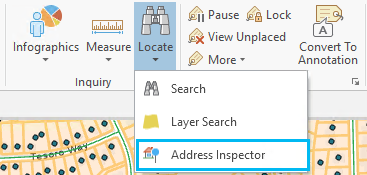
The Address Locator tool overlay window appears in the upper left of the view.
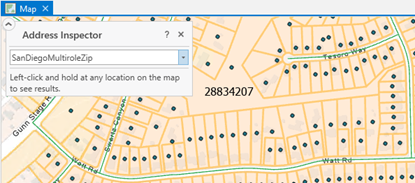
- From the locator selection drop-down menu, choose the locator you want to use to identify locations on the map.
Locators added to the project that support reverse geocoding automatically display on the Address Inspector overlay window locator drop-down menu.
The pointer turns into crosshairs.
Note:
The ArcGIS World Geocoding Service is not supported in this tool.
- Pan or zoom the map to a location where you want to identify an address or place.
- Click any location on the map.
A pop-up appears that displays the information for the address or place closest to the location that you clicked. Crosshairs showing where you clicked and a pin showing the location it matched are also displayed on the screen.
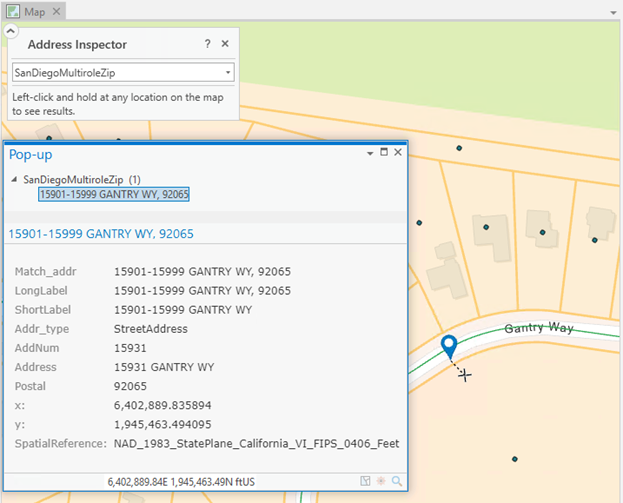
- When you are finished inspecting, click Close
 on the Address Inspector overlay window.
on the Address Inspector overlay window. Closing the Address Inspector overlay window reactivates the Explore tool
 .
.
Tip:
To change your perspective while inspecting, press the C key
to temporarily navigate using the Explore tool  . Release the C key to continue inspecting.
. Release the C key to continue inspecting.
To learn about other shortcuts you can use while the tool is active, see Keyboard shortcuts for navigation.
Tip:
Double-click the location on the map to keep the pop-up displayed. This allows you to copy any details about the location before identifying more locations.
If the locator is a composite locator, an address is returned from the first participating locator.
Note:
To find addresses for all the point features in a feature class, use the Reverse Geocode geoprocessing tool. The tool creates a new feature class containing additional fields for the returned addresses.